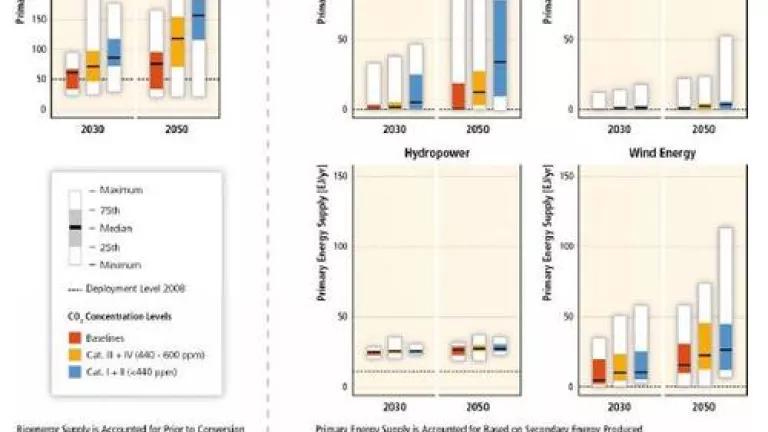
Last Monday, the IPCC released a policy makers summary of study that predicts that the world could get nearly 80% of its energy from renewable sources by 2050. The full report won't be available until the end of May.
"The report shows that it is not the availability of the resource, but the public policies that will either expand or constrain renewable energy development over the coming decades," said Ramon Pichs, Co-Chair of the Working Group III in the press release.
There have been other studies that have shown similar technical potential and it's important to regularly remind policy makers that the technologies are ready to go, we just have to choose to use them and adopt smart policies to get us there.
And therein lies a rub with the IPCC report. The summary shows a tremendous growth in the amount of bioenergy as part of its many of the scenarios that form the basis for its conclusions. For the scenarios that keep global GHG emissions concentrations below 440 ppm in 2050, the median contribution from bioenergy is more than any other renewable energy technology by a lot and bioenergy would experience more 200% growth. (At first glance, it looks like bioenergy provides more than all other renewables combined, but bioenergy is accounted for based on its primary energy value and the other renewable based on their secondary energy values, which understates their value by up to 3 fold.) The figure below, Figure SPM.11. tells the basic story, though it takes some close inspection.
Unfortunately, the section on bioenergy reads as if it were written by an industry association with a number of demonstrably false statements, such as "Most current bioenergy systems, including liquid biofuels, result in GHG emission
reductions." (page 16.) Palm oil biodiesel and current corn ethanol do not reduce GHG emissions. Then there's this doozy at the end of the section:
Proper governance of land use, zoning, and choice of biomass production systems are key considerations for policy makers. Policies are in place that aim to ensure that the benefits from bioenergy, such as rural development, overall improvement of agricultural management and the contribution to climate change mitigation, are realized; their effectiveness has not been assessed.
Statements like this, make this report really dangerous. No policy maker should be fooled into thinking the policies exist that would be needed to make the levels of bioenergy suggested by this report actually sustainable. Not only are there no examples of policies that require or encourage broadly sustainable bioenergy, here in the US, the debate is trending in the wrong direction.
As I wrote recently, EPA has proposed to entirely ignore biogenic carbon for 3 years.How can we possibly hope to induce smart, low carbon land-use, zoning or biomass production choices if we don't even count their GHG emissions? (Look for a blog soon on NRDC's comments to EPA.)
What makes this proposal and the IPCC statement particularly vexing is that it is the IPCC's accounting system that is often used to justify assumptions that bioenergy is carbon neutral. As discussed in more detail in this letter from a group of scientists to the Washington state legislature, when the IPCC was developing an inventory system for global GHG emissions, the scientists decided to account for biomass emissions as as changes in terrestrial carbon emissions and therefore count biomass combustion emissions as zero to avoid double counting them. Of course EPA isn't regulating terrestrial carbon, so ignoring the combustion emissions amounts to ignoring bioenergy pollution entirely.
So you'll forgive my frustration when EPA points to the IPCC accounting to justify a 3 year delay in counting bioenergy pollution and the IPCC releases a report saying that the policies needed to drive low-pollution bioenergy are in place.

